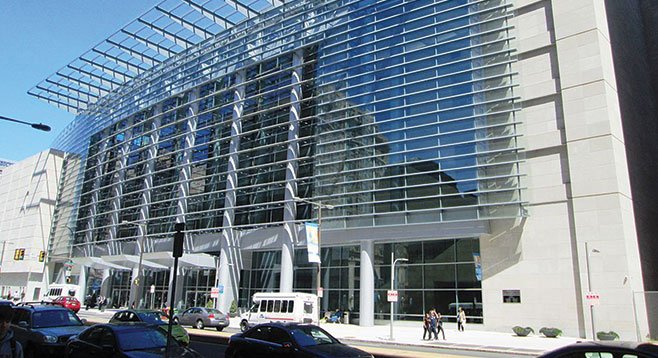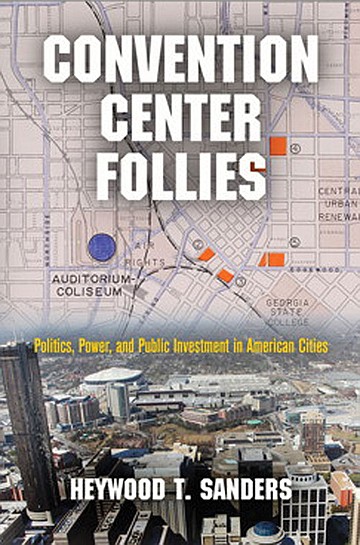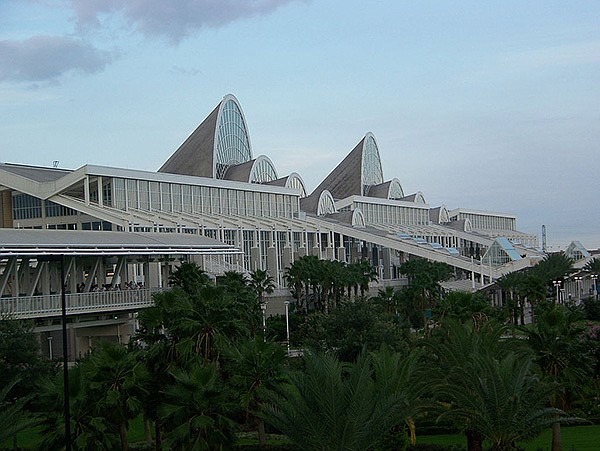 Facebook
Facebook
 X
X
 Instagram
Instagram
 TikTok
TikTok
 Youtube
Youtube

Would you take advice from a gaggle of consultants whose forecasts in the past two decades have been off by 50 percent?
Of course you wouldn’t. But all around the U.S., politicians, civic planners, and particularly business executives have been following the advice of self-professed experts who invariably tell clients to build a convention center or expand an existing one.

A remarkable new book, Convention Center Follies: Politics, Power, and Public Investment in American Cities, published by the University of Pennsylvania Press, tells the amazing story of how one American city after another builds into a massive glut of convention-center space, even though the industry itself warns its centers that the resultant price-slashing will worsen current woes.

The author is Heywood Sanders, the nation’s ranking expert on convention centers, who warned of the billowing glut in a seminal study for the Brookings Institution back in 2005. In this new, heavily footnoted, 514-page book, Sanders, a professor of public administration at the University of Texas/San Antonio, exhaustively examines consultants’ forecasts in more than 50 cities.
Nashville was told its new center would result in 466,950 hotel room nights; it’s getting around 267,000 — “a little better than half [what was projected],” says Sanders in an interview. Philadelphia isn’t garnering even half the business that was promised.
“Getting half the business [that was projected] is about the norm,” says Sanders. “The actual performance is a fraction of what it is supposed to be.”
Yet, in city after city — including San Diego — self-appointed civic leaders listen to and act on these faulty forecasts. In almost all cases, mainstream media and politicians swallow the predictions whole without checking the consultants’ miserable track records.
San Diego’s convention center — like others around the United States — is slashing prices by 40 to 50 percent to its customers but wants to build a $520 million expansion, claiming it aims to fulfill demand. But supply swamps demand — the reason for the deep price-cutting around the nation. Since the year 2000, trade-show space has grown from 52 million to 71 million square feet, while attendance has been about flat.
But such warning signals are not flashed by consultants, who are paid fancy prices by cities. Who are these error-prone consultants? They are units of major accounting firms, such as Pricewaterhouse-Coopers, KPMG, Ernst & Young, and Deloitte & Touche. Then there are private purported research firms such as C.H. Johnson Consulting and CSL International. They crank out so-called studies for cities with the same conclusion: build! Often they use the same verbiage: “They are remarkably adept at saying exactly the same thing to other cities in exactly the same words. Much of the study for Anaheim was word-for-word from the study for Baltimore,” says Sanders.

Actually, discounts are so deep they are dragging the convention centers underwater. Los Angeles convention officials made an offer to the American College of Chest Physicians for its 2016 session. The rate would be $269,918. But Los Angeles would give an incentive of $268,918. So, the cost would be $1000. But, wait. Los Angeles would offer a $25,000 marketing incentive. So, then the city would be $24,000 in the hole. But, hold on. If it got commitments, the city would give further incentives for the next couple of years, including worldwide marketing help, going deeper into the red.
“It is not even giving it away,” says Sanders. “It is giving it away and throwing tens of thousands of dollars in cash on top of it.” Then he named several other cases in which Los Angeles and other cities are “giving two or three or four hundred thousand dollars in incentives.”
In the teeth of this kind of arithmetic, Los Angeles plans to expand its convention center. “Seattle, San Francisco, Los Angeles, Anaheim, and San Diego are planning expansions. They will eat each other up,” says Sanders.
Why do the centers tolerate such nonsense — and then worsen it by expanding? The whole process is basically maneuvered by the business community — banks, hotels, retailers, construction industries, others who will profit while the city loses

“The fundamental motivation is increasing land values,” says Sanders. And picking taxpayers’ pockets.
Cities’ corporate movers and shakers long ago figured out how to get their new centers or expansions without the voters having a say. (San Diego is just one city with a kinky plan to evade going to the ballot. Two lawsuits maintaining that there should be a vote are now on appeal. If the appeals are lost, the expansion, along with a hotel, would seem in the clear, since the California Coastal Commission has given the project its okay.)
Centers have multifarious ways to cover up their failures. One method is double-counting attendees; San Francisco pulls that stunt. Another is counting nonconvention events as convention attendance. San Diego has the habit of tossing in dancers at the Rock ’n’ Roll Marathon with convention attendees — a gross statistical distortion.
More hocus-pocus: counting everybody attending an event as someone from out of town who spends money at local hotels and restaurants. When it made its 2013 forecast, San Diego’s center claimed that each Comic-Con attendee would spend $613.20. That’s absurd, says Sanders, noting that locals make up much of the audience.

Throughout the industry, statisticians assume that every convention attendee spends three and a half nights at local hotels. This inflates the figure for hotel nights and, of course, the total economic impact that the event is touted to provide. Actually, the average length of stay is around one night, taking all figures into account, says Sanders.
How can convention centers get away with such ledger-demain? Those in the know shut up, and the press, politicians, and public have neither the time nor the expertise to follow the prestidigitation.
How do the consultants get away with being 50 percent wrong most of the time? In my opinion — not Sanders’s — consultants in many fields are paid to provide answers that the people paying the consultants’ bills want to hear. And the people paying those bills are the business community — using taxpayers’ money, of course.
The worst news: “These expansions will keep happening,” as long as “you have a mayor who says it is free,” says Sanders.


Would you take advice from a gaggle of consultants whose forecasts in the past two decades have been off by 50 percent?
Of course you wouldn’t. But all around the U.S., politicians, civic planners, and particularly business executives have been following the advice of self-professed experts who invariably tell clients to build a convention center or expand an existing one.

A remarkable new book, Convention Center Follies: Politics, Power, and Public Investment in American Cities, published by the University of Pennsylvania Press, tells the amazing story of how one American city after another builds into a massive glut of convention-center space, even though the industry itself warns its centers that the resultant price-slashing will worsen current woes.

The author is Heywood Sanders, the nation’s ranking expert on convention centers, who warned of the billowing glut in a seminal study for the Brookings Institution back in 2005. In this new, heavily footnoted, 514-page book, Sanders, a professor of public administration at the University of Texas/San Antonio, exhaustively examines consultants’ forecasts in more than 50 cities.
Nashville was told its new center would result in 466,950 hotel room nights; it’s getting around 267,000 — “a little better than half [what was projected],” says Sanders in an interview. Philadelphia isn’t garnering even half the business that was promised.
“Getting half the business [that was projected] is about the norm,” says Sanders. “The actual performance is a fraction of what it is supposed to be.”
Yet, in city after city — including San Diego — self-appointed civic leaders listen to and act on these faulty forecasts. In almost all cases, mainstream media and politicians swallow the predictions whole without checking the consultants’ miserable track records.
San Diego’s convention center — like others around the United States — is slashing prices by 40 to 50 percent to its customers but wants to build a $520 million expansion, claiming it aims to fulfill demand. But supply swamps demand — the reason for the deep price-cutting around the nation. Since the year 2000, trade-show space has grown from 52 million to 71 million square feet, while attendance has been about flat.
But such warning signals are not flashed by consultants, who are paid fancy prices by cities. Who are these error-prone consultants? They are units of major accounting firms, such as Pricewaterhouse-Coopers, KPMG, Ernst & Young, and Deloitte & Touche. Then there are private purported research firms such as C.H. Johnson Consulting and CSL International. They crank out so-called studies for cities with the same conclusion: build! Often they use the same verbiage: “They are remarkably adept at saying exactly the same thing to other cities in exactly the same words. Much of the study for Anaheim was word-for-word from the study for Baltimore,” says Sanders.

Actually, discounts are so deep they are dragging the convention centers underwater. Los Angeles convention officials made an offer to the American College of Chest Physicians for its 2016 session. The rate would be $269,918. But Los Angeles would give an incentive of $268,918. So, the cost would be $1000. But, wait. Los Angeles would offer a $25,000 marketing incentive. So, then the city would be $24,000 in the hole. But, hold on. If it got commitments, the city would give further incentives for the next couple of years, including worldwide marketing help, going deeper into the red.
“It is not even giving it away,” says Sanders. “It is giving it away and throwing tens of thousands of dollars in cash on top of it.” Then he named several other cases in which Los Angeles and other cities are “giving two or three or four hundred thousand dollars in incentives.”
In the teeth of this kind of arithmetic, Los Angeles plans to expand its convention center. “Seattle, San Francisco, Los Angeles, Anaheim, and San Diego are planning expansions. They will eat each other up,” says Sanders.
Why do the centers tolerate such nonsense — and then worsen it by expanding? The whole process is basically maneuvered by the business community — banks, hotels, retailers, construction industries, others who will profit while the city loses

“The fundamental motivation is increasing land values,” says Sanders. And picking taxpayers’ pockets.
Cities’ corporate movers and shakers long ago figured out how to get their new centers or expansions without the voters having a say. (San Diego is just one city with a kinky plan to evade going to the ballot. Two lawsuits maintaining that there should be a vote are now on appeal. If the appeals are lost, the expansion, along with a hotel, would seem in the clear, since the California Coastal Commission has given the project its okay.)
Centers have multifarious ways to cover up their failures. One method is double-counting attendees; San Francisco pulls that stunt. Another is counting nonconvention events as convention attendance. San Diego has the habit of tossing in dancers at the Rock ’n’ Roll Marathon with convention attendees — a gross statistical distortion.
More hocus-pocus: counting everybody attending an event as someone from out of town who spends money at local hotels and restaurants. When it made its 2013 forecast, San Diego’s center claimed that each Comic-Con attendee would spend $613.20. That’s absurd, says Sanders, noting that locals make up much of the audience.

Throughout the industry, statisticians assume that every convention attendee spends three and a half nights at local hotels. This inflates the figure for hotel nights and, of course, the total economic impact that the event is touted to provide. Actually, the average length of stay is around one night, taking all figures into account, says Sanders.
How can convention centers get away with such ledger-demain? Those in the know shut up, and the press, politicians, and public have neither the time nor the expertise to follow the prestidigitation.
How do the consultants get away with being 50 percent wrong most of the time? In my opinion — not Sanders’s — consultants in many fields are paid to provide answers that the people paying the consultants’ bills want to hear. And the people paying those bills are the business community — using taxpayers’ money, of course.
The worst news: “These expansions will keep happening,” as long as “you have a mayor who says it is free,” says Sanders.
Comments